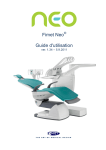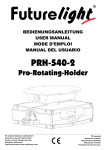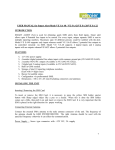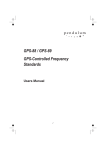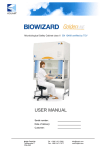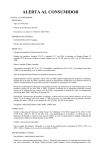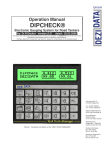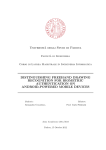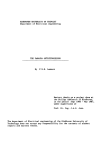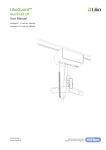Download OWNERS'S MANUAL
Transcript
OWNERS’S MANUAL FM211-1-5 File: Tuoli_E.doc 2.2.2001 OWNERS’S MANUAL F 1 PATIENT CHAIR FOREWORD ............................................................................................................................................................................ 2 UNPACKING AND ASSEMBLY OF FIMET F1 DENTAL CHAIR ............................................................................. 3 PRODUCT DESCRIPTION ................................................................................................................................................... 6 CONSTRUCTION................................................................................................................................................................. 6 MOTORS AND ELECTRONICS......................................................................................................................................... 6 THE POWER SUPPLY AND MAINS SWITCH ................................................................................................................ 7 FUSES.................................................................................................................................................................................... 7 HEADREST........................................................................................................................................................................... 8 ARMRESTS........................................................................................................................................................................... 8 BACKREST........................................................................................................................................................................... 9 LEGREST .............................................................................................................................................................................. 9 KNEE ANGLE ...................................................................................................................................................................... 9 SWIVEL ACTION............................................................................................................................................................... 10 SEAT ANGLE...................................................................................................................................................................... 10 SAFETY FEATURES......................................................................................................................................................... 11 CONTROLLING THE CHAIR........................................................................................................................................... 11 Foot control .................................................................................................................................................................... 11 Hand control.................................................................................................................................................................... 13 Joystick............................................................................................................................................................................ 13 PROGRAMMING.................................................................................................................................................................. 14 USING MEMORY POSITIONS......................................................................................................................................... 14 ASEPTIC CONTROL AND HYGIENE ............................................................................................................................. 14 SERVICE AND MAINTENANCE....................................................................................................................................... 15 THE BACKREST MOTOR AND ITS MECHANICS....................................................................................................... 15 THE MOTOR FOR THE LIFT MOVEMENT.................................................................................................................. 15 PRINTED CIRCUIT BOARD AND SAFETY SWITCH.................................................................................................. 15 SPECIFICATIONS ................................................................................................................................................................ 16 ERROR CODES AND MESSAGES OF SELF DIAGNOSTIC PROGRAM.............................................................. 17 ADDITIONAL INFORMATION.......................................................................................................................................... 19 CHANGING THE MOVEMENT LIMITS......................................................................................................................... 19 CHANGING THE MOVEMENT LIMITS IN JOYSTICK CHAIR.................................................................................. 20 GIVING THE RIGHT TRANSMISSION CODE TO THE FOOT OR HAND CONTROL ........................................... 21 CODING THE FOOT AND HAND CONTROL............................................................................................................... 21 PACKAGE POSITION........................................................................................................................................................ 22 0-POSITION ........................................................................................................................................................................ 22 CHANGING THE FACTORY PROGRAMMED 0-POSITION...................................................................................... 22 SPITTOON PROGRAM ..................................................................................................................................................... 22 TROUBLE SHOOTING........................................................................................................................................................ 23 PRINCIPLE OF EPROM MARKINGS............................................................................................................................. 23 TO REDUCE NOISE LEVEL AT MOTOR ...................................................................................................................... 24 TIGHTENING THE LOOSE POTENTIOMETER LOCKING SCREW......................................................................... 24 TWO OR MORE CHAIRS MOVING BY THE SAME REMOTE CONTROL ............................................................. 24 WIRING DIAGRAM.............................................................................................................................................................. 25 DIMENSIONS......................................................................................................................................................................... 26 RECOMMENDED INSTALLATION................................................................................................................................. 26 Fimet Oy reserves the right to change specifications without prior notice. All rights reserved Copyright Fimet Oy FM211-1-5 File: Tuoli_E.doc 2.2.2001 OWNERS MANUAL 2 FOREWORD Our congratulations on the decision to invest in high quality F1 patient chair. We wish that your work with it will be enjoyable and problem free. Fimet F1 chair is electrically controlled, multi-functional patient treatment chair for medical purposes. Because of its flexibility, it can be used not only as a Dental chair but can be modified to be used also as an ENT, Ophthalmology and Podiatry patient chair. It can be used as well for barber and cosmetology applications. This well-designed chair is also easy to use. For example the armrest can swing out, so it is easy to get into the chair, and thereby make it easier for elder or invalid patients. Because the whole chair top can be rotated, it is also easy to use it in a small room. The chair is controlled by remote foot- or hand control. In some applications two fixed joystick type foot controls are also available. The microprocessor inside of the chair is controlling the chair and performing self diagnose of itself constantly. It is possible to store eight working positions in the chair’s memory. The whole control system as well as the motors run on 24 volts, which makes the chair absolute safe for both patient and the doctor It is possible to select from various color possibilities; an appropriate combination that suits the room colors. The chair’s upholstery has been designed to minimize the amount of seams and thereby maximize hygiene. The upholstery can be of polyurethane, vinyl or genuine leather. The upholstery is easy to clean and, if necessary, replace. OWNERS MANUAL 3 UNPACKING AND ASSEMBLY OF FIMET F1 DENTAL CHAIR Unpack the chair from the transportation box and check that all parts are enclosed and undamaged. Contents: o Owners manual o The chair o Backrest with bracket o 3 Allen screws for backrest bracket o Power supply with mains cord o Headrest with bracket o 2 armrests o 2 covers for armrest holder o Foot rest o Foot control Check that the voltage marked on the power supply corresponds to the voltage of your mains outlet. Power supply Contents Connect the chair to the power supply by means of the multiconnector plug 8 pole connector OWNERS MANUAL Open the rear end of the foot control by bending the soft cover upwards and gain thereby access to the rechargeable batteries. Connect the batteries and fold back to cover. Charge the batteries before use (see page 12) If there is a unit: Remove the upholstery by undoing the locking rings at the armrest attachments by means of rotating the plastic locking ring anticlockwise. Lift the upholstery upwards and slide forward. Remove the sheet metal by opening two screws and pull the plate away. Connect the wires coming from the F1 E unit color-to-color in terminal block and attach the flat cable in it’s counterpart. Connect the power supply in a grounded wall socket. Be sure that the voltage rating is same in the wall socket and in power supply. Turn on the power by means of the switch on the power supply. The green pilot lamp will now light up. Wait approx. 30 seconds before operating the chair. The built-in microprocessor checks that all functions and controls are in order. If there is a unit: Raise the chair approx. 15 cm (6 inches) by means of the foot control (push the right-side button for lift) and fit the unit in its adapter iron located beside and below the chair seat. Adjust the position of the unit by using adjustment screws in the adapter iron and tight the unit firmly in its place. (Refer to a separate “Quick Installation Quide”. Restore upholstery and lock it in its place by using plastic locking rings. Attach the armrests to the chair. 4 OWNERS MANUAL 5 Attach the bracket for the backrest to the chair by means of the three screws and slide the backrest on the bracket. Mount the headrest in the slot of the backrest one corner diagonally ahead. The chair is now ready for operation, please see instructions on the following pages. ∇ WARNING! The chair must be securely fastened to the floor or to a solid steel plate prior to use in the operatory, in order to prevent that the chair tilts over. OWNERS MANUAL 6 PRODUCT DESCRIPTION CONSTRUCTION The chassis and foundation of the F1 chair are made of a sturdy steel construction. The geometry of the up- and down mechanism has an ingenious compact design that offers the chair outstanding flexibility. From its lowest point 35 cm ( 14 inches) the chair moves almost linearly to 91 cm ( 36 inches). All bearing are pre-lubricated and will last almost indefinitely without maintenance. All visible parts are made of composite materials by using the RIM technique ( Reaction Injection Molding). The seat, backrest and other force absorbing parts are reinforced. MOTORS AND ELECTRONICS The two motors and the electric circuitry of the F1 chair are of low voltage type that reduces the risk of electrical shock and hazard to a minimum. Steel and composite materials in combination are used in the gears of the drive mechanism. A configuration that gives the chair a smooth and quiet ride and a long lifetime of the mechanism. The electronics, including the microprocessors for the programming functions are concentrated on one circuit board that are conveniently located on the right hand side of chair. All major components of the F1 chair are easily accessible for fast and convenient service and maintenance. Safety switch: All movement will stop when the rear is lift upwards Backrest motor Lift motor Recharge connector All functions of the F1 chair are controlled by means of a cordless foot control that meet the individual needs of convenience. Control panel Batteries Safety switch Foot control OWNERS MANUAL 7 THE POWER SUPPLY AND MAINS SWITCH The transformer, the rectifier, the mains switch and the fuses are all housed in a separate power supply box, apart from the chair for improved safety. Always turn off the mains switch when the chair is not in use. Power switch Fuses Pilot light F NOTE! Connections Power cord When switching on the mains, wait approx. 30 seconds before operating the chair. The built-in microprocessor is checking that all functions and controls are in order. (Self diagnostic) FUSES The fuses (T 2 A) are housed in the power supply box and are easily accessible. If the power supply is located in the Floor Box (in firm installation), there is only one fuse, otherways always 2 pcs. F NOTE! There is a overheating protection switch built-in to the power supply box. In case where the transformer overheats the overheat protection switch will cut the circuitry to the chair immediately. When the transformer cools down the safety switch will automatically go back to its on position. When overheat protection is functioning the display of the chair indicates H (Hot). OWNERS MANUAL 8 HEADREST The compact headrest has an anatomic design and offers the best possible support while holding the head firmly in place. By releasing the lever on the left side, the headrest can be adjusted to almost any desired position. The headrest is also easy to adjust longitudinally up to 20 cm by moving it in and out of the slot in the backrest. Position adjustment Longitudinal adjustment ARMRESTS The armrests can be turned 90 degrees sidewards and are easy to remove in order to provide better access and make it easy for elderly or disabled people to get in and out of the chair. To turn the armrests, lift approx. 2,5 cm (1 inch) and turn towards desired direction. Remove the armrest by pulling it straight up. There are two covers provided with the chair which should be placed in the armrest holders if armrests are not used. As an option, there are two extra arm supports available that can be attached to the sides of the backrest. OWNERS MANUAL 9 BACKREST The backrest can be extended up to 10 cm in order to accommodate any patient. To adjust the length just push the button on the lower part of the backrest and move the backrest in the desired direction. Don’t let the backrest fall without restrain, support it with hand. Release the locking button after locking position is found. LEGREST The legrest is extendible up to 10 cm, (4 inches). In order to adjust the length, just move the legrest to the desired position. There are two locked positions for the legrest, all the way in and fully extended. KNEE ANGLE The knee angle is easily adjusted into two different positions. By lifting the front end of the legrest and by pressing the foremost release button simultaneously the angle can be increased or decreased. The movement of the legrest is synchronised with the backrest as well as the knee angle. Knee angle adjustment OWNERS MANUAL 10 SWIVEL ACTION The F1 chair rotates ± 90 degrees from its neutral position. To turn the chair, open the locking lever on the right side of the chair and turn the chair by hand to the desired angle. Lock the lever when done. Swivel lever SEAT ANGLE The angle of the seat can be adjusted into two different positions. By pushing the middle release button on the right side of the chair and pushing the backrest with other hand the seat is released and can be adjusted. Note that this adjustment must be done without patient. The angle of the seat is synchronised with backrest. Seat angle F Trendelenburg position NOTE! In the event of an emergency the chair can be moved into the so called Trendelenburg position by pushing the middle button and flipping the chair backwards. The chair must be in a horizontal position in order to do this. OWNERS MANUAL 11 SAFETY FEATURES A safety switch is located on the printed circuit board on the right side under the chair. If something (e.g. a foot) come in between the lifting mechanism and the base of the chair when the chair is in motion, this safety switch will immediately stop all movements. The chair can be restarted as soon as whatever caused the stop has been removed. For improved safety the foot control also works as an emergency stop switch. Hit any of the control switches of the foot control when the chair is in motion and all movements of the chair stops immediately. Safety switch. Activated when rear is lift upwards. Activate any button for emergency stop CONTROLLING THE CHAIR F NOTE! If some other device is disturbing wireless remote control transmission, immediately start using remote controls with recharge cable. FOOT CONTROL All movements of the F1 chair are controlled by means of the cordless foot control. The foot control contains all functions for the manual operation of the chair. It can be used also for controlling F1 unit options. In addition, the foot control is used for programming and activating different pre-set working positions. Transmission of the electro-magnetic signals between the foot control and the chair is accomplished by means of inductive fields. In cases when you have more than one F1 chair in your office the foot controls have different codes in order to prevent any interference. The foot control is operated by rechargeable accus size AA. To charge the accus just connect the foot control to the cord that is provided with the chair. In the event of malfunction in the cordless transmission, connect the cord used for charging the accus to the foot control. This will override the cordless transmission, and the chair can now be operated as usual. Do not use normal batteries instead of accus in the foot control! F Hint: If accus have exhausted, the chair can be operated as normally with recharge cable. 3 2 Lever 1 Batteries OWNERS MANUAL 12 OPERATION OF THE FOOT CONTROL Seat up: ⇒ Seat down: ⇒ Backrest down: ⇒ Backrest up: ⇒ Memory recall ⇒ Button 1 Button 3 Lever left Lever right Button 2 + some other function In the right and left sides of the foot control lies two buttons; in the edge and on the top. These buttons are connected parallel so the same function is performed from both buttons. 3 DOWN 2 1 UP RECHARGING FOOT CONTROL BATTERIES The foot control contains four rechargeable 1.2 V accus (Ni-Cd) for operation of the cordless transmission. Recharging time is about 24 hours. Typically recharging must be performed three to six week intervals. If there is also F1 E unit attached, the need of recharge is increased. When the display on the back of the chair indicates A, it means the accus need to be recharged. If the chair is operated during recharging process the recharge time is longer. ∇ WARNING! Do not replace the rechargeable accus delivered with the chair with any other type of batteries. Always use genuine batteries provided by Fimet Oy or exactly same Ni-Cd type AA. Using non rechargeable batteries you are exposed to danger! RECHARGING: o Connect the other end of the recharge cable to the bottom of the foot control and other end to front of the chairs base. Refer to the picture on page 6. o The batteries will now automatically recharge. When the batteries are recharged, disconnect the recharge cable. Connection of recharge cord OWNERS MANUAL 13 HAND CONTROL Manual: Backrest up Automatic: 0-position (exit postition) Manual: Chair up Automatic: Upper working position Manual: Backrest down Automatic: Lower vorking position Manual: Chair down Automatic: Recall of the previous position Pushing this button again causes the chair to go back in to that position where it was before first pushing. Position recall: Push here and within three seconds any button marked with an arrow and the chair will move automaticly in preprogrammed position. F1 ja F2 Used only in some special modified chairs. Recharging connector The hand control does not need to be pointed towards the chair like for example tv:s remote control because hand control works with different principle. The range is about 2 m and it works best when held in horisontal position in hand. Hand control has same kind of coding system like foot control. When the chair is controlled with both hand and footcontrol, they must possess the same coding. RECHARGING HAND CONTROL BATTERIES Connect the provided recharging cable in to the connector located in the other end of the hand control and the other end to the recharge connector located back at the chairs base part. Some chairs have separate holder for the hand control which has recharging function built-in. Just place the hand control in it’s holder and it will recharge automaticly. JOYSTICK The third way to control the chair are joysticks. Joysticks are firmly positioned to the base of the chair and are easy to operate to the doctor and nurse. BACKREST UP LEFT RIGHT BACKREST DOWN CHAIR DOWN CHAIR UP CHAIR DOWN Manual use: Turn joystick in desired position to drive the chair Recall position: Turn the joystick shortly in to that direction where the desired position is saved and release it to middle position. The chair beeps shortly after succesfull recall-action. OWNERS MANUAL 14 PROGRAMMING The chair has eight memory places for different positions, four places for user A and four places for user B. Memory positions are stored as double actions in control buttons. F1 FIMET OY FINLAND USER A CODE USER B USER PROG Chair’s back panel o Select user / operator (A/B) by pushing Programming button (PROG) User selection A/B (USER) Display USER o Drive the chair to the desired position o Push the PROG button on the back panel of the chair, release it and within 3 seconds select the memory place by selecting one of the buttons of the foot (or hand) control or by moving joystick. The program is now saved. o Repeat the procedure in order to program other working position in the next memory place. (Memory place lever-right is programmed at the factory and can’t be changed usual way.) o Change user / operator by pushing USER again. The user B -light will flash. Repeat the programming procedures as for user A. USING MEMORY POSITIONS Use the desired preset working position by pushing the PROG -button of the foot (or hand-) control once and within 3 seconds select the memory place you want use. When the chair is running, all movements can be stopped at any time by activating any button or lever. The safety switch also stops all chair movement. Programming succestion: Lever right: Lever left: Left button: 0-position (programmed at factory) working position rinse position Memory position left-button is also called as ”rinse position”. Program this memory place so that the chair moves into a position whereby it is convenient for the patient to rinse. Use the function by pressing first PROG -button and then left (rinse) button of the foot control. Return to the original position just by pressing the “rinse” button again. ASEPTIC CONTROL AND HYGIENE All surfaces of the F1 chair are smooth and the upholstery is without seams for improved hygienic properties and aseptic control. The polyurethane parts are easy to wipe clean with your regular detergent, alcohol or other disinfectants. Fimet recommends “Super Blue” -detergent adulterated to 2…4 % strong liquid. Plastic parts, such as chair’s base cover, is best to clean with soap and water or with dish washing liquid. OWNERS MANUAL 15 SERVICE AND MAINTENANCE F NOTE! The warranty expires and Fimet Oy declines all responsibility if somebody else but Fimet Oy's authorised service course passed qualified serviceman maintain or repair this device THE BACKREST MOTOR AND ITS MECHANICS To gain access to the backrest motor: o Remove the armrests and the locking rings that holds the upholstery in place o Lift the upholstery carefully off the armrest holders and slide it forward of the chair o Remove the two screws that holds the metal cover in place, and remove it o The motor and the mechanics of the backrest as well as the mechanics of the control buttons are now easily accessible THE MOTOR FOR THE LIFT MOVEMENT The motor for the lifting mechanism is accessible from the front of the chair. o Remove the four screws that holds the cover on place. o If the chair is being serviced for the first time the plastic cover needs to be cut open. Use a sharp knife and cut both sides along the grooves from bottom to top. o Fold the plastic cover carefully upwards. The motor is now accessible for service. PRINTED CIRCUIT BOARD AND SAFETY SWITCH The printed circuit board and the safety switch are located on the right hand side of the chair next to the lift mechanism. To gain access, remove the plastic cover by releasing the front corner that snaps over the metal guide, and then cranking it off carefully. Slip display panel through back cover hole at the same time. The plastic cover and the bellows are inter connected by means of mechanical retention and are easily separated. When the cover is removed from the chair the circuit board is easily accessible for service. OWNERS MANUAL 16 SPECIFICATIONS Fimet F1 chair Mains connection The separate power supply connects to: 230 V ±10 % 50 Hz or 110 V ±10 % 60 Hz Electrical data 24 VDC low voltage motors Microprocessor controlled, self diagnostic Chair operates at 24 V DC 450 VA Humidity Operating: 30 - 75 %, storage & transportation: 10 - 100 % Temperature Operating: +10 - +40 ºC, storage & transportation: -40 - +70 ºC Protection against electric shock Class I Protection against liquids Drip-proof IPX I Operation mode Continuous operation with short-time loading Fuses T 2 A two pieces Mounting To be fixed to the floor or heavy metal plate Chassis Welded steel frame. All visible parts cast in composite material Max lift weight 180 kg or 400 Lbs Net weight 110 kg or 240 Lbs Upholstery Upholstery, headrest and armrests cast composite material. Additional materials on demand. Movements Seat height max. 91 cm or 37 inches, min. 35 cm or 14 inches The initial seat height adjustable 10 cm or 4 inches by factory Backrest angle 90° Rotation ± 90° Trendelenburg angle 9° In the case of problems please contact retailer. The manufacturer will assist also if required. Fimet Oy Teollisuustie 6 FIN 07230 Monninkylä Phone +358 19 521 6600 Fax +358 19 521 6666 E-mail: [email protected] OWNERS MANUAL 17 ERROR CODES AND MESSAGES OF SELF DIAGNOSTIC PROGRAM When the microprocessor of a F1 chair detects a fault it tries to inform about the most probable reason. The error code is showed on the display of the chairs rear panel. Starting from program version 6A.8B the program version is showed on the display when power to the chair is switched on. This information can also be helpful when trying to find reason for a problem. In error codes there are two numbers (shown after each other) and the numbers are showed twice. Error codes which start with number 1 are for lifting motor, 2 is for backrest motor and error codes starting with 5 are for potentiometers. It must be noticed, that no matter what error code is shown, the reason might be elsewhere. Example: Fault code 50. A wire to the potentiometer of the lifting motor is broken or the potentiometer is defective. The problem might be on the main pc-board, wires, on a terminal connector, connector between the wires and pc-board, connector between the wires and potentiometer or the potentiometer. In case several problems occur at the same time the processor informs about the problem, which has lowest number, for example when the voltage is low, the showed error code is 10 (not 20). Error codes 10, 20: Low voltage (or missing) for motors 12: A wire to the lifting motor is broken 13: Wires to the lifting motor are shorted 22: A wire to the backrest motor is broken 23: Wires to the backrest motor are shorted 50,51: A wire to the potentiometer of the lifting motor is broken or the potentiometer is defective. 52,53: A wire to the potentiometer of the backrest motor is broken or the potentiometer is defective. If the potentiometers are mechanically turned to its maximum or minimum values, these same codes are displayed. 54,55: Lift (54), backrest (55): Movement limits too near each other or too near mechanical limit {from ver. 6A8B6} 56,57: Lift (56), backrest (57): Some unlogic in the limits (e.g. upper limit < lower limit) {from ver. 6A8B6} 11, 14, 15, 16, 21, 24, 25, 26: Main printed circuit board is defective. E, EE: (EEPROM) EEPROM is defective. Error message E is shown also when a position is tried to be stored on channel 1 ( backrest down). U: (Unit) Unit-adapter is connected to the chair, but the main processor can't get any reply from the unit. Same error message comes, if instrument is picked up before turning power on. Notice, that after "U"-error, the unit can't be used. Before power is switched OFF or safety switch is shortly activated. OWNERS MANUAL H: 8: 18 (Hot) Motor is too hot. Analog memory is charged with voltage which is proportional to the current motors are using. When the current is too high too long time it is supposed that motors are too hot and to prevent motors to be destroyed the current is turned off. (All leds are on) Processor is in reset - state. 0: Blinking (Zero) Safety switch is pressed. This is actually no Error-code, but means, that microcontroller is not working correctly. At the same time buzzer is usually on. A: (Accumulator) when charge of accus is decreased to a low level (and foot control is on) display is showing "A" (this "A" may sometimes occur also when noise is partly destroying the signal so that microcontroller "misunderstands" battery information). Messages why movement is stopped If chairs movement is stopped before the chair has reached wanted position, to the display comes the reason for the stop. Always when motor is stopping there comes a code of the reason for the stop. If the movement was all right the code is not showed. One thing to notice is that if noise is disturbing foot controllers signal, microcontrol can't say if command was interrupted or not. So there will be not any code to show, though movement stop was not natural. Messages when driving manually When driving a chair manually only one motor at a time is moving. Used codes for exceptional stops of movements are as follows: 5: Software current limit 6: Hardware current limit 7: Lower limit, 8. Upper limit; 9: No movement; microprocessor stops supply of current to the motor electronics stops supply of current to the motor the chair has reach the minimum level (soft limit) the chair has reach the maximum level (soft limit) the value of potentiometer doesn't change (automatic) 16 A 9A 8A Messages when driving automatically If one or both movements are stopped exceptionally, so that the chair doesn't reach the programmed position, the reason for that is showed in following formula: 1X2Y: where X and Y are replaced by a reason code 5 - 9. If there is no problem the code is 0. 1 = Liftmotor 7A 2 = Tiltmotor Example: into the display comes following code 1025. This means, that lifting motor has reached the programmed position (1 for lifting motor, 0 for OK), but backrest motor has been stopped by the processor, because the current was too high (2 for backrest motor, 5 for software current limit downwards). Reason for the error could be a mechanical obstacle under the backrest. If the automatic movement is stopped by a new command, code F comes to the display. OWNERS MANUAL 19 ADDITIONAL INFORMATION CHANGING THE MOVEMENT LIMITS G Changing of the movement limits must left to be made by authorized service personnel. Do not never drive the lift motor to the mechanical limits because the transmission may be damaged. Shall be made if new limits of movements are needed or in case of changing the potentiometer or the pc-board, if the old EEPROM has not been changed from the old pc-board to the new one. Programming goes as follows: LIFT: (chair moves) Upper limit when metal ring comes visible Lower limit ⇒ press USER Upper limit ⇒ press USER Lower limit ⇒ press USER TILT: (backrest moves) Lower limit ⇒ press USER Upper limit ⇒ press USER Lower limit ⇒ press USER Lower limit when plastic strip reaches the urethane part of the base 1. If possible, move chair and backrest to their approx. middle positions. 2. Short-circuit 6-pin connector (all pins together) at the chair-pc-board just next to the processor circuit (special short-circuit piece available). If there is also Fimet F1 E unit attached to the chair, the other flat cable must first be detached. 3. Press the 4. Activate security switch at the bottom edge of the pcb-board and release it. (keep pressed)) 5. Press any switch at the foot control. Now Beep, Beep, Beep sound should be heard. Release PROG -switch and foot control. 6. Chair goes now downwards (it can only be stopped at the security switch or at the mains switch). Press the USER -switch at the desired lowest limit. Now the chair start going upwards. 7. PROG -switch and keep it down PROG still OWNERS MANUAL 20 8. Press again the 9. Press once again the USER -switch exactly at the same lowest limit than first time. Now the lowest and highest limits are set and the chair stops at this position. USER -switch at the highest limit. Now the chair goes downward again. 10. Backrest starts moving. Set the limits for backrest at the same way described above by pressing the USER -button at the limits. 11. When limits are set, remove the short-circuit piece. F NOTE! In case of emergency, activate the security switch or switch off mains. If these happens you must make whole procedure again. It is not possible to program a single limit but all together. CHANGING THE MOVEMENT LIMITS IN JOYSTICK CHAIR G Changing of the movement limits must left to be made by authorized service personnel. Do not never drive the lift motor to the mechanical limits because the transmission may be damaged. The programming procedure described here is only advisable to be made by this way when there is no foot or hand control! Refer “Changing the movement limits” above. 1. Carefully remove the back urethane of the chair. Release the display panel and slip it through the hole in the urethane to the other side. 2. Unscrew two screws of the plastic microprocessor case which held the top cover in place. Examine carefully how the emergency switch, spring and other associated parts are constructed together. 3. Locate 6-pin flat cable at the right side of the processor circuit and joystick adapter pcb at the main pcb. That cable is later to be removed and replaced by short-circuit piece. Press down the PROG -button at the rear panel of the chair and KEEP it down until further notice. 4. 5. Activate the emergency switch on the bottom edge of the main pcb and release it. The processor now starts waiting for joystick-command. 6. Move the joystick to any direction. “Beep beep beep” -sound should now be heard. 7. Release the 8. Now there is 12 seconds to remove the 6-pole flat cable and replace it with short-circuit piece. If the time runs to the end, the whole procedure must start all over again. 9. The chair starts to moving downwards. Use the USER -button to mark the limits as described in chapter “Changing the movement limits” on page 19. PROG -button from the back panel of the chair and joystick to its middle position. 10. After setting limits for lifting, the backrest movement limits must be set too. Use again to set the limits. USER -button 11. Detach the short-circuit piece and re-install the 6-pole flat cable in its place. Check those new movement limits by driving the chair to them. OWNERS MANUAL 21 12. Re-assembly the chair in opposite order than dismantle. Pay extra attention for assembling the security switch and check its behavior again when the chair is fully assembled again. GIVING THE RIGHT TRANSMISSION CODE TO THE FOOT OR HAND CONTROL To be made after changing the foot control or the hand control, after changing chair’s main pc-board or after changing EEPROM circuit in main pc-board. 1. Press PROG -button in chair’s back panel and keep it pressed during points 2 and 3 2. Activate security switch and release it. (Lift back panel from the chair’s rear. The “0” should be blinking on the display). 3. Press any button from foot control and release it after ”Beep, Beep, Beep” sound. In case of bringing a new remote control (hand or foot) to the system, make sure that they have the same ”hard-coding”, in other words, that the jumper in 10-pin jumper block of both remote controls is in the same place. CODING THE FOOT AND HAND CONTROL To be made when afterwards accuired hand control is wanted to control same chair with foot control. The simpliest method is to open both controls and organize short circuit pieces at the same way 1 2 3 4 5 12345 In most cases, opening of the foot control can be avoided, because the code is written in the bottom of it. The code can be for example“2-3”, which means that there is two short circuit pieces used in places 2 and 3. (Refer to the picture above.) If there is no marking, the following procedure can take place instead of opening the foot control: 1. 2. 3. 4. 5. Open the hand control Remove short circuit pieces from the 10 pin connector Push PROG -button down from the hand control and keep it pushed With a screwdriver make a short circuitry between 1-1, 2-2,...5-5 Put the short circuit piece in that place where the chair makes a ”Beep” sound If there are 2 short circuit pieces at the foot control, the above mentioned doesn’t work. In this case: OWNERS MANUAL 22 6. Put the short circuit piece to place 1-1. Keep the PROG -button pushed down. 7. With a screwdriver, make a short circuitry between 2-2, 3-3, 4-4, 5-5. 8. If no ”Beep”-signal, put the short circuit piece to 2-2, and make a short circuitry with a screwdriver to 3-3, 4-4, 5-5 etc. PACKAGE POSITION In order to place the chair in its package, the chair can be driven below its lowest position. Press USER -switch (from back panel of the chair) and at the same time press ”chair down” switch at the foot control. F NOTE! Chair’s backrest must be at the package position also. Don’t drive the chair at it’s mechanical limit. 0-POSITION Since 12.12.1990 there is 0-position or exit position firmly programmed at the factory. This position is recalled by pressing PROG -button from the foot control and activating “backrest-up” -function. 0-position: PROG + backrest up. CHANGING THE FACTORY PROGRAMMED 0-POSITION Drive the chair to the desired 0-position (exit position). Push first PROG (from back panel of the chair) and then turn foot control lever rightwards. USER so that both remain pushed down and SPITTOON PROGRAM This program works when foot controls middle button ( PROG -button) is pressed and within three seconds the left corner button. Pushing left button again brings the chair in it’s original position. The spittoon position is programmable like any other position. OWNERS MANUAL 23 TROUBLE SHOOTING Twitching backrest Chair’s backrest is moving down but it always stops after few centimeters when manually driven but moves correctly when automatically driven. Solution: The reason is at the electric current limit, which is all the time checked by the processor. The backrest motor takes too much current. In chairs, which have been moving correctly before, this is due to the gradual stuck of the backrest motor. Current to correct functioning motor is between 2 and 4 A, and is limited in downward moving to 7 A. If there are other disfunction as well (lift motor is cutting off as well), the reason may be in remote transmission. Measures: o If the reason seems to be the remote control, try to drive the chair with recharge cable connected. If other hand or foot control is available, try with it. (Remember to put the same ”hard code” for the new remote control). o Check the gears by eye, that they are in condition. If not, change the complete motor. o Put a little bit of white grease on the drive screw. o If it doesn’t help, check next that the case of the motor hasn’t moved from its place; check that the motor fitting screws are tight. There is the possibility, that the rotor is sticking with the field magnets; knock slightly the motor itself with a soft hammer to free the sticking rotor. o If it doesn’t help, put little bit oil on the brake. o The failure can be at the measuring of current on the main pc-board. Change the pc-board. o If it doesn’t help, change the complete backrest motor. Current limits: Lift 16 A Tilt 7 A PRINCIPLE OF EPROM MARKINGS For instance the marking 6A.8B3 Marks left from the point are for ”hardware”, right for ”software”. Old EPROM could always be replaced by a new one presuming new software version is same or newer. For instance, 6A.8B3 could be replaced by 6A.8B8 OWNERS MANUAL 24 TO REDUCE NOISE LEVEL AT MOTOR The noise may be reduced by slightly changing the position (angle) of the motor to its fitting plate. This is done by slightly tightening the other M6 screw and by loosening the other (appr. half a round). It may be necessary to slightly loosen the ∅ 6 screw in the middle and to tighten it again. 6 6 M6 M6 φ 32 G Do not try to adjust the motor unless really necessary. TIGHTENING THE LOOSE POTENTIOMETER LOCKING SCREW In some older F1 chairs following failure has been found: There is irregular problems in backrest movement by manual or/and automatic operation. The reason for this can be loose locking screw, witch should lock the ∅ 10 mm steel axle to the backrest pivot bar. The backrest potentiometer is fixed to this axle and the axle should rotate with the pivot bar, when the backrest is moving. The head of the locking screw is hidden 2-3- mm under the polyurethane surface at the end of the pivot bar, see picture. There is a small cut in polyurethane to reach the screw head. Tighten the locking screw after having put it in its middle position and set the limits. (The above described failure is also possible in lift potentiometer.) TWO OR MORE CHAIRS MOVING BY THE SAME REMOTE CONTROL In some cases following problem has occurred, if the dentist has two or more F1 chairs in the same surgery. When the foot (or hand) control of one chair is activated, the other chair starts also to move. The reason is following: both chairs have the same transmission code in the remote controls. Solution: Open the foot control by loosing the 2 fastening nuts under the foot control and by taking away the plastic cover. Now there is in sight 2x5 pcs code pins and there is one or more short circuit connectors (jumpers) between the two lines. Change this coding by changing the place of the short circuit connectors. If the chair has a remote hand control as well, make the same code into the hand control after opening it. To teach the new code to the chair, follow the instruction in ”Giving the right transmission code…” (page 21). In newer chairs the code number (=places of jumpers) is written at the bottom plate of the foot control. OWNERS MANUAL WIRING DIAGRAM 25 OWNERS MANUAL 26 DIMENSIONS 490 380 190 8 ø1 556 506 506 467 480 600 255 500 380 1 ø1 M5 M10 380 468 Base plate (optional), thickness 15 mm RECOMMENDED INSTALLATION The base of the chair



























